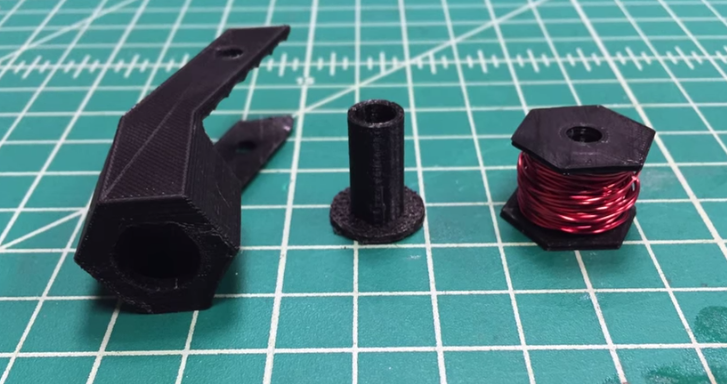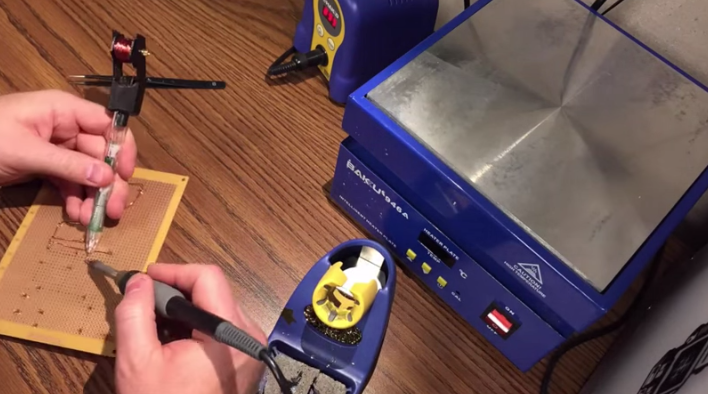 There are those who use pencils, and then there are those who use mechanical pencils. This is a tool that many become so accustomed to, they refuse to use any other pencil due to the multi-faceted qualities offered in terms of writing, drafting, doing quick calculations, and even finely-tuned drawings. Now, thanks to Instructables member Proto G, a mechanical engineer from Florida who knows a thing or two about mechanical pencils and managing wire when prototyping PCBs, you can mix the two.
There are those who use pencils, and then there are those who use mechanical pencils. This is a tool that many become so accustomed to, they refuse to use any other pencil due to the multi-faceted qualities offered in terms of writing, drafting, doing quick calculations, and even finely-tuned drawings. Now, thanks to Instructables member Proto G, a mechanical engineer from Florida who knows a thing or two about mechanical pencils and managing wire when prototyping PCBs, you can mix the two.
Considering the actual setup of the mechanical pencil, which is very, very simple, it’s amazing there aren’t more hacks like this. It just took a mechanical engineer with a propensity for making things like this to point out the obvious. With his very cool 3D printed attachment, not only can you manage wire easily–you’ll be the envy of all your peers who will want a 3D printed pencil topper too, wire managing needed or not.
“This is a 3D Printed attachment I designed that transforms an ordinary mechanical pencil into an awesome wiring pencil for prototyping,” says Proto G in his Instructable. “It was inspired by the old school Roadrunner and Verowire wiring pencils.”
Proto G uses a Papermate 0.5mm mechanical pencil which will allow you to manage 0.5mm wire in an organized fashion. For an example, he used it with a thin enamel coating, causing it to melt easily during the soldering process. It’s the very definition of an awesome gizmo, with the attachment sitting right atop the pencil allowing you to load up with wire and go.
 All you need is the following to make your own:
All you need is the following to make your own:
- One Paper Mate Clear Point 0.5mm mechanical pencil
- Magnet wire with enamel for soldering, with a diameter of 0.5mm or less
- 3D printed parts for attachment (download STL files from the Instructable)
- Any nut and screw with a 0.2″ diameter or less, with a length of at least 1″
- Glue, as in super glue (cyanoacrylate) or hot glue
For use, this mechanism is as easy as advancing a small amount of wire and soldering it until the enamel melts and waiting briefly for it to harden up before advancing on to the next solder joint.
“I like to use tweezers and snips like in the video,” said Proto G. “You can even use thin solder to make a soldering pencil to go with your wiring pencil.”
 Herein lies the beauty of not only managing your prototyping wire, but the comprehensive benefit of using just a bit of digital design resourcefulness coupled with 3D printing. This isn’t a contraption you will find ready-made to your liking and contained in a mechanical pencil anywhere else that we know of. With the progressive technology of 3D printing, you are able to take matters into your own hands at remarkably little expense–and keep that wire spooled in an organized fashion.
Herein lies the beauty of not only managing your prototyping wire, but the comprehensive benefit of using just a bit of digital design resourcefulness coupled with 3D printing. This isn’t a contraption you will find ready-made to your liking and contained in a mechanical pencil anywhere else that we know of. With the progressive technology of 3D printing, you are able to take matters into your own hands at remarkably little expense–and keep that wire spooled in an organized fashion.
Have you made anything or considered making something similar to this with 3D printing? Discuss in the Mechanical Pencil 3D Printed Prototyping Attachment forum thread over at 3DPB.com.
Subscribe to Our Email Newsletter
Stay up-to-date on all the latest news from the 3D printing industry and receive information and offers from third party vendors.
You May Also Like
Precision at the Microscale: UK Researchers Advance Medical Devices with BMF’s 3D Printing Tech
University of Nottingham researchers are using Boston Micro Fabrication‘s (BMF) 3D printing technology to develop medical devices that improve compatibility with human tissue. Funded by a UK grant, this project...
3D Printing Webinar and Event Roundup: April 21, 2024
It’s another busy week of webinars and events, starting with Hannover Messe in Germany and continuing with Metalcasting Congress, Chinaplas, TechBlick’s Innovation Festival, and more. Stratasys continues its advanced training...
3D Printing Webinar and Event Roundup: March 17, 2024
It’s another busy week of webinars and events, including SALMED 2024 and AM Forum in Berlin. Stratasys continues its in-person training and is offering two webinars, ASTM is holding a...
3D Printed Micro Antenna is 15% Smaller and 6X Lighter
Horizon Microtechnologies has achieved success in creating a high-frequency D-Band horn antenna through micro 3D printing. However, this achievement did not rely solely on 3D printing; it involved a combination...





























